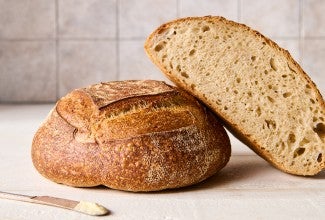For better steam, bake your bread with towels
A tray of wet kitchen towels in the oven can deliver continuous steam for crispy, crunchy crust.
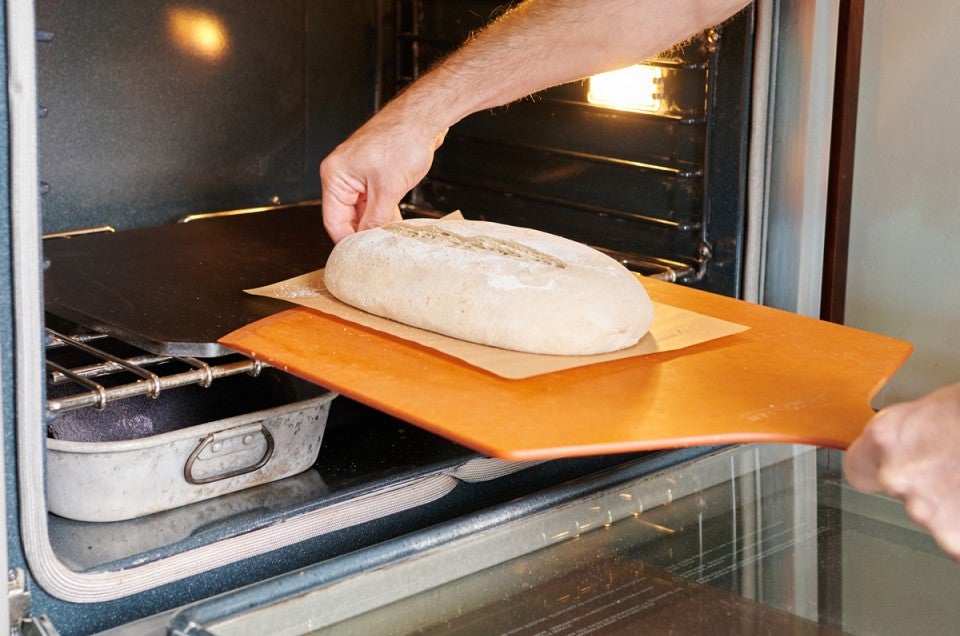

King Arthur contributor Maurizio Leo has a new book coming out November 8: The Perfect Loaf: The Craft and Science of Sourdough Breads, Sweets, and More. Today, he’s sharing one of his book’s most surprising tips: how (and why) to bake your bread with towels.
(Heads up: At King Arthur, we only recommend cookbooks and products that we, as bakers, truly love. When you buy through external links on our site, we may earn an affiliate commission.)
* * *
As a home bread baker, I’m obsessed with steam. Specifically, how to get the most steam possible in my run-of-the-mill home oven when baking bread.
A healthy dose of steam at the beginning of baking helps promote a tall, golden, and shiny loaf with a brittle crust. The steam we work so hard to introduce in the oven helps keep the surface of the dough moist and elastic while baking, allowing it to rise fully for maximum volume.
The challenge is that the typical home oven isn’t designed to bake with steam inside, whereas a commercial bakery oven has optimal steam at the press of a button. Home ovens encourage dry roasting, resulting in food with a browned, crunchy crust (case in point: that wonderfully crisp-skinned Thanksgiving turkey). To ensure dry heat is circulated, the vents in a home oven allow the moisture from roasting food to escape, making it hard to steam well.
With bread baking, we want this dry heat too, just not so early. If a loaf starts baking in a dry oven, the crust dries prematurely and can’t optimally expand, resulting in less rise and a dull crust. So there’s a balance: ample steam at the beginning (usually about 20 minutes in a home oven) and then finish baking in a dry oven.
So now that we know we want steam when baking, what’s the best way to get it?
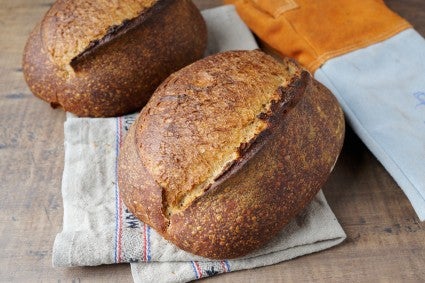
Over the years, I’ve tested myriad ways to add more steam to the oven when baking bread. The simplest approach, popularized by many notable bakers, is to bake bread with an “oven inside of an oven.” Using a lidded pot, like a Dutch oven or combo cooker, traps the moisture escaping from the dough inside, providing just the right steamy environment. While this method is easy and effective, there’s just one problem: What if we want to bake more than one loaf at a time or a loaf that’s a shape other than that of our pot?
My love of a long and tapered bâtard — which won’t fit in a round pot — prompted me to search for a different approach to steaming when baking bread at home. Instead of baking in a pot, a well-known method for steaming home ovens is to put a pan on a lower rack (or at the bottom) of the oven, beneath the baking bread, and throw ice or water into it. This creates an initial blast of steam that fills the oven and moistens the dough.
But back to the problem of home ovens: They have vents. So that initial blast of steam, while beneficial, quickly dissipates and the dough is left back in a dry environment sooner than optimal.
So for an even shinier crust, I like to place a second pan in the oven next to the pan where ice is thrown: one that holds a few tightly rolled kitchen towels saturated with boiling water. Before loading your dough in the oven, place that wet-towel-filled pan in there alongside the pan where you throw ice or water.

This approach continually steams the oven even after the pan with ice/water uses up all its liquid. The towels create steam slowly but continuously as they bake in the oven, turning the absorbed water inside the towels to steam. The steady steam results in loaves with more volume and a crust that’s shiny and delightfully crispy.
I know what you might be thinking: towels in the oven — won’t those burn to a crisp? I typically use two to three towels, and as long as they’re completely saturated with boiling water, they never get a chance to bake completely dry. Additionally, the pan with towels is removed after the initial 20 minutes in which steam in the oven is beneficial, so there’s no danger of burning the towels. And to be safe, I always use towels that don’t have any exposed tags.
(One note: If you have a convection oven, I prefer not using it with this steaming method. The fan blows around the steam in the oven and tends to prematurely dry the dough.)
Roasting pan (with optional culinary-grade lava rocks or ceramic briquettes), or another oven-safe pan like a cast-iron skillet
A second roasting pan (or any oven-safe pan or shallow pot)
If your baking surface (such as a baking stone or baking steel) is wide enough, you should be able to bake two oval loaves side by side using this method. If you’re baking two smaller rounds (boules), they might fit catty-corner to each other.
Regardless of how many loaves you bake, I find it helpful to get everything ready before you score your dough.

Place a baking steel/stone on an oven rack in the bottom third of the oven and an empty roasting pan at the bottom of the oven to one side. (If your oven has exposed heating elements at the bottom, place a rack as low as possible to hold the roasting pans, then use another rack above for the baking steel/stone.) I like to fill this pan with culinary-grade lava rocks or ceramic briquettes to increase the hot surface area, but this is optional. Preheat your oven to the temperature specified in your recipe. (Here, I’m making Pain au Levain.)

To a second roasting pan add two to three cotton kitchen towels rolled tightly and placed snugly against each other in the center of the pan. Turn a kettle on and boil about two cups of water (to completely saturate three towels).
Fill a container with two cups of ice and set it next to the oven.
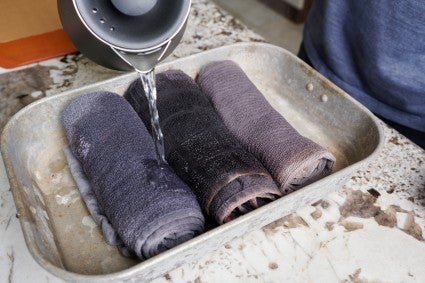
Before scoring your dough, pour the boiled water over the rolled-up towels in the roasting pan until completely saturated, then slide the pan into the bottom of the oven, next to the roasting pan already preheating in the oven.
Transfer your dough from its proofing basket to a parchment-lined pizza peel (or inverted baking sheet or cutting board). Score the dough. Slide the dough with the parchment paper directly onto the baking surface in the oven.
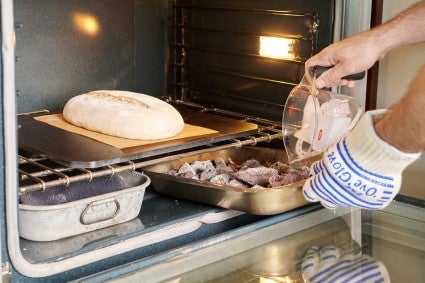
Carefully pour the container of ice into the roasting pan without the rolled-up towels and shut the oven door. Let the dough bake according to the recipe. For free-form loaves, recipes typically indicate baking with steam for the first 15 to 25 minutes in the oven. After this time, remove both of the roasting pans used for steaming from the oven. Continue baking the dough for the remaining time specified in the recipe.

I know: It’s strange placing kitchen towels in your oven to bake bread. But while this approach is different, it’s incredibly effective. Once you see the results from this extra steam, what once seemed strange might now be your go-to approach to baking bread.
The Perfect Loaf was named one of our best baking books of 2022 — find the full list in our Holiday Gift Guide.
Cover photo by Maurizio Leo.
